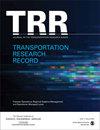公路噪声暴露公平性
IF 1.8
4区 工程技术
Q3 ENGINEERING, CIVIL
引用次数: 0
摘要
这篇文章讨论了暴露在高速公路噪音中的不平等,这可能对健康、生产力和生活质量产生不利影响。如果由于结构不平等、中产阶级化、缺乏社会资本或其他原因,某些亚群体倾向于住在高速公路附近,那么高速公路的噪音就会以一种系统的方式加剧不平等。作者开发了一个在线地图应用程序,即噪声不公平识别工具(NIIT),以可视化道路噪声污染的噪声损害成本,县级噪声公平比率以及各种人口统计数据的人口分布。该方法结合了来自享乐定价文献的道路交通噪音水平和噪音损害成本的估计,以及受影响的家庭数量的估计,以估计美国每个道路段的噪音损害成本。然后,每个人口的噪音损害成本在更大的区域内汇总,并按其人口比例归一化,以计算“噪音权益比”。揭示了高速公路噪声暴露在不同空间尺度人口统计之间的巨大不平等。通过使用这一工具,规划者和从业者可以很容易地识别现有公路噪音暴露不平等的地区,并查明噪音损害成本过高的道路,以推荐潜在的外部性缓解项目。本文章由计算机程序翻译,如有差异,请以英文原文为准。
Equity of Highway Noise Exposure
This article discusses the inequities in exposure to highway noise, which can have adverse effects on health, productivity, and quality of life. If certain subpopulations tend to live near highways because of structural inequality, gentrification, lack of social capital, or other reasons, then highway noise can contribute to inequity in a systematic way. The authors developed an online mapping application, the Noise Inequity Identification Tool (NIIT), to visualize the noise damage cost of noise pollution from road segments, the noise-equity ratios at the county level, and the population distribution of various demographics. The methodology combines estimates of roadway traffic noise levels with the cost of noise damage from the hedonic pricing literature and estimates of the number of households affected to estimate the noise damage cost for each road segment in the U.S. The cost of the noise damage accruing to each demographic is then aggregated over a larger region and normalized by their proportion of the population to calculate the “noise-equity ratio,” revealing substantial inequities in highway noise exposure between demographics at a variety of spatial scales. By using this tool, planners and practitioners can easily identify regions with existing highway noise exposure inequities and pinpoint roadways with excessive noise damage costs to recommend potential externality mitigation projects.
求助全文
通过发布文献求助,成功后即可免费获取论文全文。
去求助
来源期刊

Transportation Research Record
工程技术-工程:土木
CiteScore
3.20
自引率
11.80%
发文量
918
审稿时长
4.2 months
期刊介绍:
Transportation Research Record: Journal of the Transportation Research Board is one of the most cited and prolific transportation journals in the world, offering unparalleled depth and breadth in the coverage of transportation-related topics. The TRR publishes approximately 70 issues annually of outstanding, peer-reviewed papers presenting research findings in policy, planning, administration, economics and financing, operations, construction, design, maintenance, safety, and more, for all modes of transportation. This site provides electronic access to a full compilation of papers since the 1996 series.
 求助内容:
求助内容: 应助结果提醒方式:
应助结果提醒方式:


